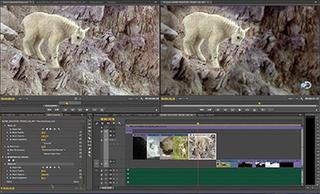Full 4K Editing Not Ready for Primetime

Adobe Premiere Pro CC 2014 is frame-size agnostic, and can handle images up to 10K.
LOS ANGELES—Just how real is 4K/ultra HD editing?
According to Adobe video editing product manager Al Mooney, very real indeed. “It is practical, otherwise people wouldn’t be doing it,” he said. “‘Gone Girl,’ a really massive project, was an entirely native 4K workflow, and they’ve been working successfully.”
Of course not every project has the budget of an anticipated Hollywood blockbuster— Director David Fincher’s “Gone Girl” is reportedly budgeted at $50 million. And delivering 4K to TV screens is still a work in progress. But UHDTV sets are being marketed aggressively, which drives home the point that 4K—including ultra HD, its 3840x2160-pixel flavor—is a matter of when, not if.
TV Technology checked in with nonlinear editing manufacturers to see how ready they are for what seems to be an inevitable future.
FRAME-SIZE AGNOSTIC
Mooney reports that Adobe Premiere Pro has been 4K-capable since the 64-bit Creative Suite 5 with its GPU-accelerated Mercury Playback Engine. “While 4K was supported in CS4, it was really CS5 when the power kicked in,” he said. “Premiere Pro is actually frame-size agnostic, and goes up to 10K.” Also since the last few releases, Adobe uses the GPU to de-Bayer 4K media, which results in “a dramatic performance improvement.”
At the same time, Mooney notes that the Japanese market now wants 60p 8K. “Dynamic range, color space, resolution will all get higher,” he notes. “We’ll always have to invest in engineering and technology to get the best in the system.”
Get the TV Tech Newsletter
The professional video industry's #1 source for news, trends and product and tech information. Sign up below.
EVOLVE WITH NEW WORKFLOWS
Avid can ingest 4K with Avid Media Access, said David Coloantuoni, senior director of product management for Avid in Burlington, Mass. “Because 4K is just emerging in a larger scale, we’ve been taking an approach that allows us to adapt as more workflows come out,” he said. “On our ISIS product line today, we can playback 4K material, so if a customer were to finish in Blackmagic’s DaVinci color correction, you could keep your 4K assets on the ISIS and use that to finish while interacting with Media Composer.”
The goal is to evolve Avid’s products along with the new 4K/UltraHD workflows. “We want full 4K/UltraHD/resolution- independent pipeline that lets you take the material directly into Media Composer, play it back and editing it,” Coloantuoni said. “Once we do that, we’ll start to fill in the gaps with the rest of the workflow.”
Al Mooney, Adobe A ‘SERIOUS PIPE’
Sony Creative’s Vegas Pro has been supporting 4K workflows for four years, said Michael Bryant, director of marketing and product manager for Vegas Pro. “We support the RED camera’s native R3D file as well as two types of XAVC files, which is becoming known as an UltraHD file,” he says. “The amount of files you’re moving around has increased, and you need a powerful computer and the new SSD-type drives to make it work.”

Bryant predicts that, just as sports and late night shows drove the evolution to HD, so these TV genres will lead the evolution into 4K TV. But he warns that the successful launch of 4K/UltraHD requires more than just a standard. “Streaming UltraHD/4K is going to take a serious pipe,” he said. For that reason, he said, “The best way today to truly deliver 4K material would be on a shiny disc.” And Vegas Pro is ready for that task right now. “With Vegas Pro, you can run a script to automate the process of creating an MPEG file, an AVC file for Blu-Ray and archive it as a 4K file for the future.”
A BIG STEP FORWARD
Lightworks from Boston-based EditShare is upping its 4K capabilities, according to Product Manager Matt Sandford. “We’re set to release version 12 which is a big step forward,” he said. “It will be an entirely new OS on Windows, Linux and Mac for the first time. For the moment, we have support for RED including up to 5K and ProRes 4K files. We don’t have output to 4K but we support Blackmagic, AJA and Matrox which gives us ingest and output to SD and HD and up to 2K. We’ll be adding 4K support there as well.”
Sandford said that his clients have been asking for 4K but not specifically for ultra HD. “Nobody is broadcasting 4K at the moment and editing 4K natively will be difficult unless you have a hulking central storage. A lot of people are shooting in 4K but not necessarily delivering in it.”
Apple is enabling 4K editing with its new, two-GPU MacPro, which offers real-time 4K performance, including multiple layers of effects from a 4K source. Bringing the Apple ProRes codec from camera into Final Cut Pro X software enables the user to set up timelines in DCI, ultra HD and any other flavor of 4K. But a real-time performance, even on the new MacBook Pro, is achieved via what Apple calls “dynamic scaling.”

David Coloantuoni, Avid Technology Which brings us to the point of how editors work. Since the advent of HD, editors have maintained the offline/online paradigm, working with proxy images tied to their full-resolution source footage. UltraHD/4K, with its dramatically increased demands on bandwidth and storage, seems unlikely to change that way of working, at least in the near future.
“As an acquisition format, 4K has many advantages and eventually as a distribution format, it may take over,” said Steve Cohen, ACE, editor on FX Networks’ “The Bridge,” and author of “Avid Agility.” “But it hasn’t caught on yet in feature and television editing rooms, because we are still using an online/offline paradigm, working with compressed material and then conforming. 4K doesn’t offer much in that environment and it takes a lot of horsepower that could be better used for the basic work of editing.”
In other words, although cameras, computers and NLE software programs may be ready for 4K/ultra HD, the bandwidth and storage demands for a fully functional real-time workflow are still not in place. 4K/ultra HD editing is just getting started.
